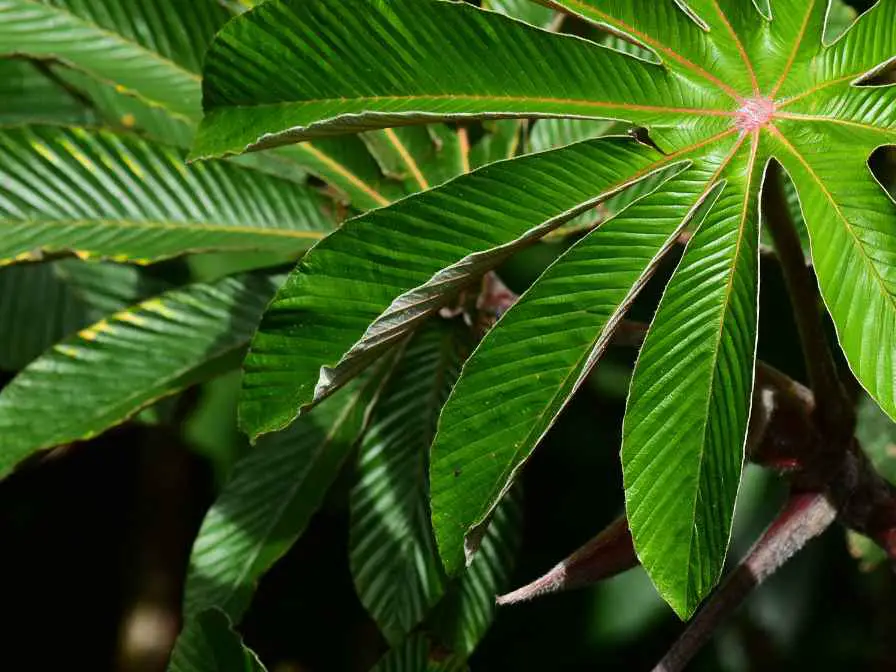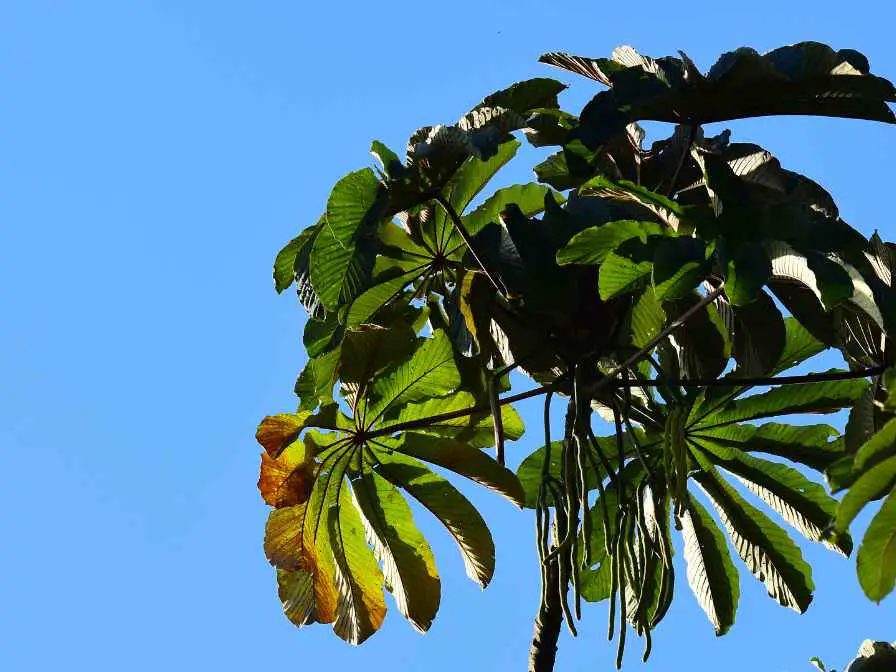Want a plant that has the ornamental as well as medicinal and other values of using fruit and even leaves? You got it right, the cecropia plant is such a plant. Most gardeners don’t know how to plant cecropia. Well, we are going to tell you about that.

Cecropia Plant
Cecropia, also known as the Cecropia tree or the Trumpet tree, is a large and impressive plant species belonging to the family Urticaceae. Native to tropical and subtropical regions of the Americas, including Central and South America, Cecropia is known for its unique appearance and ecological significance.
Cecropia trees are fast-growing and can reach heights of up to 50 meters, with a distinctive umbrella-like canopy that can span up to 20 meters in diameter. The leaves are large, palmate, and deeply lobed, with a rough texture and prominent veins.
The tree trunk is often hollow and filled with a spongy material that provides structural support, and it is punctuated with characteristic symmetrical, vertical slits known as pseudo stems.
One of the most fascinating aspects of Cecropia is its ecological role as a pioneer species. Cecropia trees are often the first to colonize disturbed areas, such as abandoned agricultural fields or clear-cut lands, due to their rapid growth and resistance to the many different environmental conditions.
Interesting Facts About Cecropia
The Cecropia tree also has a unique mutualistic relationship with a specific species of ant, known as Aztec ants, which live in hollow stems and protect the tree from herbivores in exchange for food and shelter. This symbiotic relationship makes Cecropia an important component of tropical rainforest ecosystems, providing habitat and food for a wide range of organisms.
In addition to its ecological importance, Cecropia has also been used by indigenous peoples for various purposes. The wood of the Cecropia tree is lightweight and soft, making it suitable for carving and crafting, and the leaves have been used for medicinal purposes in some traditional cultures.
However, it should be noted that the Cecropia tree can also become invasive in some regions outside its native range, and proper management is necessary to prevent negative impacts on local ecosystems. Overall, Cecropia is a fascinating plant species with unique ecological and cultural significance, making it a subject of interest for researchers, conservationists, and nature enthusiasts alike.
Benefits of Planting Cecropia Plant
There are many benefits of planting cecropia plants. some of these are here as follows:
Ecological Restoration
Cecropia is known as a pioneer species, meaning it is one of the first plants to colonize disturbed areas. Planting Cecropia trees in degraded lands, such as abandoned agricultural fields or clear-cut areas, can help jumpstart ecological restoration efforts by providing shade, reducing erosion, and improving soil quality.
Cecropia’s rapid growth and ability to adapt to many environmental conditions make it an excellent choice for reforestation projects, helping to restore natural ecosystems and provide habitat for wildlife.
Biodiversity Conservation
Cecropia trees play a vital role in supporting biodiversity in tropical rainforest ecosystems. The hollow stems of Cecropia trees provide shelter for a specific species of ant, known as Aztec ants, which get shelter and food from plants and repel the herbivores away from them.
Sustainable Resource Use
Cecropia trees have been traditionally used by indigenous peoples for various purposes, such as crafting, carving, and medicinal uses. By planting Cecropia trees in a sustainable manner, and with the involvement and consent of local communities, it is possible to support the sustainable use of Cecropia as a natural resource, contributing to local livelihoods and cultural heritage.
Carbon Sequestration
Like other trees, Cecropia trees utilize photosynthesis to take carbon dioxide out of the air and store it as biomass. This helps to slow down climate change by lowering greenhouse gas emissions. Planting Cecropia trees, especially in deforested or degraded areas, can help sequester carbon and contribute to efforts aimed at combating climate change.
Educational and Recreational Value
Cecropia trees are unique and fascinating plants that can serve as educational tools and recreational attractions. Their large size, distinctive appearance, and ecological significance make them interesting subjects for nature education and environmental awareness programs.
They can also provide recreational value by creating green spaces for people to enjoy, such as parks or botanical gardens.
How to Plant Cecropia
Here are the steps to follow while planning to plant the cecropia plant:
Choose a Suitable Planting Site
Cecropia trees prefer tropical and subtropical regions with well-drained soils and ample sunlight. Choose a planting site that receives plenty of sunlight and has well-drained soil. Avoid planting Cecropia trees in areas prone to flooding or with compacted soils.
Obtain Cecropia Seeds or Saplings
Cecropia trees can be propagated from seeds or saplings. Seeds can be collected from mature Cecropia trees, and saplings can be purchased from reputable nurseries or obtained from local sources.
Prepare the Planting Hole
Dig a planting hole that is slightly larger than the root ball of the Cecropia sapling. The hole should be deep enough to accommodate the root system without bending or crowding the roots. Make sure the soil is well prepared for the plant.
Plant the Cecropia Sapling
Place the Cecropia sapling in the planting hole, ensuring that the root ball is level with the surrounding soil. Backfill the hole with soil, gently tamping it down to eliminate air pockets. Water the sapling thoroughly to settle the soil and help establish root growth.
Provide Support if Needed
Cecropia trees have soft wood and can be prone to wind damage, especially when young. If your planting site is exposed to strong winds, consider providing support to the sapling, such as staking it with a sturdy stake or tying it to a nearby tree or structure to help it establish upright growth.
Monitor Growth and Adapt Care as Needed
Monitor the growth and development of the Cecropia tree over time and adjust care practices as needed. As the tree grows taller, it will require less frequent watering, but it may need additional pruning to maintain its shape and prevent overcrowding of branches.
Taking Care of Cecropia Tree

Here are some tips to take good care of the cecropia Tree plant
Watering
Cecropia plants prefer consistently moist soil but are not waterlogged. Water your Cecropia plant regularly, especially during dry periods, and ensure that the soil is evenly moist. Avoid wetting the leaves.
Light
Cecropia plants thrive in bright, indirect sunlight. Place your Cecropia plant in a location that receives ample sunlight but is protected from harsh, direct sunlight, especially during the hottest part of the day. A location near a window with filtered sunlight or in a partially shaded area of your garden can be ideal.
Temperature and Humidity
Cecropia plants thrive in warm and humid environments. They prefer temperatures between 20-30°C and high humidity levels. You can increase humidity around your Cecropia plant by misting its leaves with water or placing a tray of water near the plant to create a humid microclimate.
Fertilization
Cecropia plants are light feeders and do not require frequent fertilization. You can fertilize your Cecropia plant with a balanced, water-soluble fertilizer once every month during the growing season.
Pruning
Cecropia plants may require pruning to maintain their shape and size. Prune any dead, yellowing, or overcrowded leaves and branches to promote healthy growth. You can also pinch back the tips of the branches to encourage bushier growth.
Pest and Disease Control
Keep an eye out for any signs of pests, such as aphids or mealybugs, and diseases, such as powdery mildew, and take appropriate measures to control them promptly. You can use natural or chemical methods depending on your preference, but be sure to follow the recommended application instructions and safety precautions.
In short, the cecropia plant needs specific care to get along. You need to select the right place for it to make sure it grows well and gets good light. Keep it in shape to control the size of the plant. you can plant it at a place where other plants can’t be planted. It will cover the space easily.
FAQs
Where is Cecropia from?
Cecropia plant belongs to the area of central and South American forests. It is also found on the Mexican coasts as well. It is also known as the pioneer plant. This tree can grow up to a height of almost 2600 meters.
Can humans eat cecropia leaves?
Yes, besides eating the fruit of the cecropia plant, you can eat the leaves as well. It is because these leaves are widely used for herbal medicines in South American countries. It is believed to cure heart and respiratory diseases.
What is the cecropia tree used for?
Cecropia plant has many uses. You will see that it is used to make the restoration of the ecosystem where there is no plant, as this is an invasive plant. The fruit and leaves of cecropia are used to treat many diseases as being used in herbal medicines.

